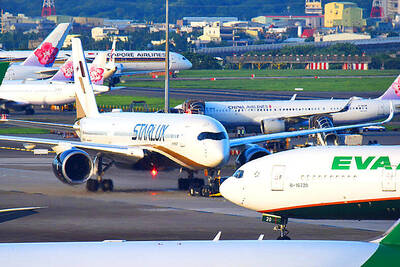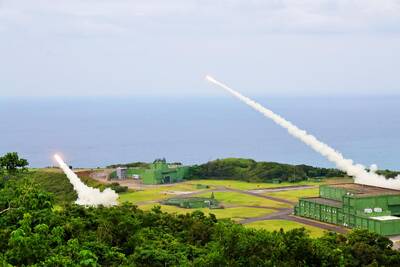China has jumped into the flap caused by a column on Taiwan that was printed last month in the Financial Times, and is now officially talking about “early” unification.
“Let me outline China’s position on this major issue of principle,” says Dai Qingli, a spokesperson for the Chinese embassy in the UK.
In the original column, printed last month, Financial Times Asia editor David Pilling argued that the US should not sacrifice Taiwan and throw it as a “bone” to what he described as “the Chinese dog.”
Pilling said that Taiwan was a “jewel” and that the vast majority of Taiwanese remain implacably against unification.
As reported in the Taipei Times yesterday, the column caused William Bader, a former chief of staff of the Senate Foreign Relations Committee, to write to the London newspaper charging that the administration of US President Barack Obama had “shown little to no knowledge or real interest” in the Taiwan Relations Act (TRA).
Bader urged the White House to read and follow the TRA which commits the US to provide Taiwan with defensive weapons.
That letter and the column that provoked it, have generated enormous interest amongst Taiwanese -Americans worried that US -support for Taiwan could be lagging.
Now Dai has joined the fray.
In a letter given almost as much prominence as Bader’s letter, Dai said: “There is only one China in the world. Both the mainland and Taiwan belong to one China. China’s sovereignty and territorial integrity are indivisible. In recent years, cross-strait relations have been improving.”
“People-to-people exchanges are thriving. Blood is thicker than water. Taiwan is not a ‘bone’ which can be thrown at will by foreign countries. The Chinese people on both sides of the Taiwan Strait have the wisdom and capability to achieve the early reunification of China, she wrote.”
“The Taiwan issue concerns the dignity of the 1.3 billion Chinese people. We firmly oppose any interference in the Taiwan issue by any country or any person. China has consistently opposed US arms sales to Taiwan. In the three China-US Joint Communiques, the US acknowledged that there is but one China and undertook to gradually reduce arms sales to Taiwan, leading over time to final resolution,” she added.
China experts in Washington said that the letter appeared to be written is such a way as to suggest that it had actually been composed in Beijing and that it was in effect a message directed at the White House.
“China will continue to work with the US to handle Taiwan--related issues properly on the basis of one China and the three communiques to safeguard overall China-US relations and peace and stability across the Taiwan Strait, the letter added.
“Unfortunately, whenever cross-strait relations improve, there are people who try to stir up confrontation, and even clamor for continued arms sales by the US to Taiwan,” she wrote.
“This is very harmful to peace, stability and development across the Taiwan Strait and in the region. We trust that FT (Financial Times) readers will not be misled by these acts which go against the trend of the times,” she wrote.

Trips for more than 100,000 international and domestic air travelers could be disrupted as China launches a military exercise around Taiwan today, Taiwan’s Civil Aviation Administration (CAA) said yesterday. The exercise could affect nearly 900 flights scheduled to enter the Taipei Flight Information Region (FIR) during the exercise window, it added. A notice issued by the Chinese Civil Aviation Administration showed there would be seven temporary zones around the Taiwan Strait which would be used for live-fire exercises, lasting from 8am to 6pm today. All aircraft are prohibited from entering during exercise, it says. Taipei FIR has 14 international air routes and

Taiwan lacks effective and cost-efficient armaments to intercept rockets, making the planned “T-Dome” interception system necessary, two experts said on Tuesday. The concerns were raised after China’s military fired two waves of rockets during live-fire drills around Taiwan on Tuesday, part of two-day exercises code-named “Justice Mission 2025.” The first wave involved 17 rockets launched at 9am from Pingtan in China’s Fujian Province, according to Lieutenant General Hsieh Jih-sheng (謝日升) of the Office of the Deputy Chief of the General Staff for Intelligence at the Ministry of National Defense. Those rockets landed 70 nautical miles (129.6km) northeast of Keelung without flying over Taiwan,

City buses in Taipei and New Taipei City, as well as the Taipei MRT, would on Saturday begin accepting QR code payments from five electronic payment providers, the Taipei Department of Transportation said yesterday. The new option would allow passengers to use the “transportation QR code” feature from EasyWallet, iPass Money, iCash Pay, Jkopay or PXPay Plus. Passengers should open their preferred electronic payment app, select the “transportation code” — not the regular payment code — unlock it, and scan the code at ticket readers or gates, General Planning Division Director-General Liu Kuo-chu (劉國著) said. People should move through the

The Ministry of National Defense (MND) today released images of the military tracking China’s People's Liberation Army (PLA) movements during the latest round of Chinese drills around Taiwan. The PLA began "Justice Mission 2025" drills today, carrying out live-fire drills, simulated strikes on land and maritime targets, and exercises to blockade the nation's main ports. The exercises are to continue tomorrow, with the PLA announcing sea and air space restrictions for five zones around Taiwan for 10 hours starting from 8:30am. The ministry today released images showing a Chinese J-16 fighter jet tracked by a F-16V Block 20 jet and the